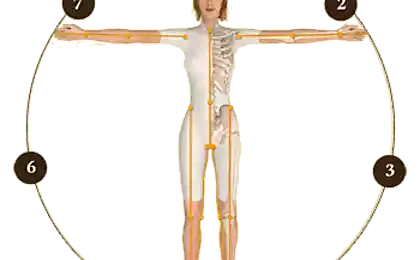634
Newgrange (or architects are too greetings)
Newgrange - religious buildings in Ireland, one of the oldest structures on the planet. It was built so that at dawn, on the shortest day of the year - the winter solstice, the sun's rays for a very short time light chamber at the end of a long corridor. Rays come in through the narrow slit, and a lucky few manage to see it live.
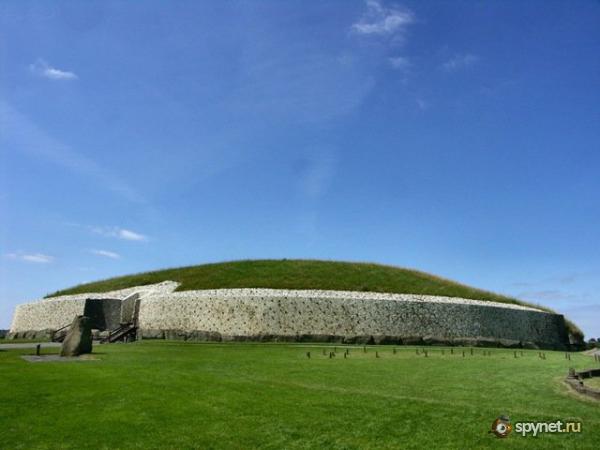
A huge complex of Newgrange (Newgrange) was built between 3100 and 2900 BC, which means that it approximately 5000 let.V Newgrange Neolithic period, served as a center for rituals and ceremonies. Later, it was added to the many other monuments.
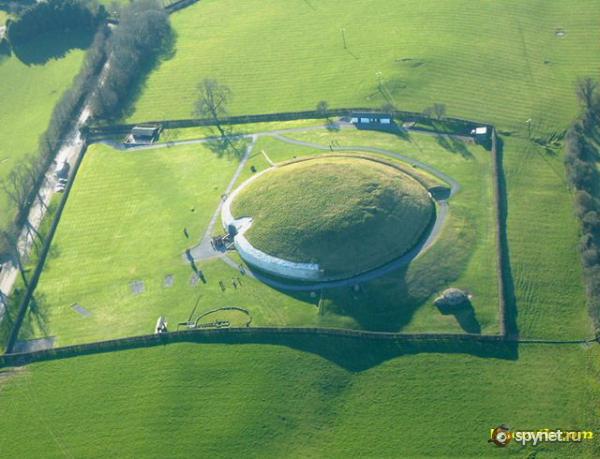
Over time, the complex began to decrease due to the subsidence of the embankment, and soon disappeared completely. This area has long been used as farmland. In 1688 these lands passed into the possession of Charles Campbell. It was his servant found Newgrange, when looking for the stones for construction. At first it seemed to them a simple construction of the cave, but then was found a long, narrow passage leading to the great room.

The workers immediately reported the discovery to the owner, who told this antiquarian, naturalist and philologist Edward Luidja. As a result, Luidja Newgrange announced his discovery and called it a tomb, to put it simply prehistoric tomb. Later, many questioned this hypothesis, for example, Charles Vallance, who thought that this place probably used for rituals and astronomical purposes. In 1983, Martin Brennan published the book "Stones of Time," which results in a lot of detail to refute the theory of the burial tomb.

Large-scale studies began in 1962 under the direction of Professor Michael J.. O'Kelly. Newgrange was excavated and restored, was built around a wall of quartzite and granite to strengthen the embankments. This recovery has displeased the archaeological community, critics argue that such technology did not exist when this building was erected. Another reason for the discontent was the fact that the stones were brought from other regions of the country.

The height of the mound - 13 5 m, diameter - 85 meters. 18-meter-long corridor leads to the burial chamber, consisting of vertically set stone monoliths weighing 20 to 40 tons. Location burial chamber reminiscent of Stonehenge, only here on top of the roof is covered with stone embankment of earth and rubble. It is necessary to pay tribute to the mysterious builders of this building, for 5000 years, the roof leaked, and almost does not pass moisture until now.

Inside the chamber, a large preserved ritual bowl and carved niches in the walls, decorated with stone carvings. Above the bathroom is a stepped vault. Monoliths, its generators are arranged so that the bottom of the stones are darkest and their weight is reduced at the vertex. The dome forms a hexagonal shaft tapered upwards to a height of 6 meters.

The tunnel is directed to the southeast, to the side of the sunrise at the winter solstice. Above the entrance is a hole - a window of 20 cm in width, through which sunlight can penetrate to the inside of the room. Within a few days (mid-December), the rays of the rising sun penetrate through the tunnel into the chamber and brightly illuminate it for about 20 minutes.


Few wishing allowed to watch the beautiful spectacle of the penetration of sunlight into the inner chamber at dawn. For example, in 2005 there were only 50 people selected from 27,000 applicants. To determine the lucky conducts special lottery allowed only 10 visitors a day. The moment of penetration of the sun's rays can be seen in the photo below:
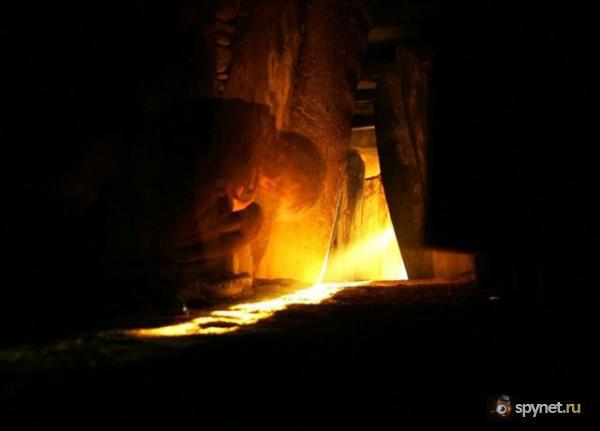


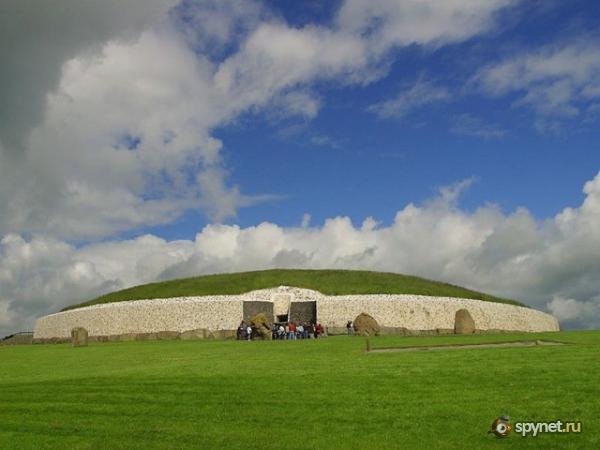
In 1993, UNESCO officially awarded the archaeological complex of Brú na Bóinne international status of the historical monument. In the list of World Heritage Newgrange described as the largest and most important of megalithic structures in Europe. More than 200 000 people visit this unique archaeological monument annually.
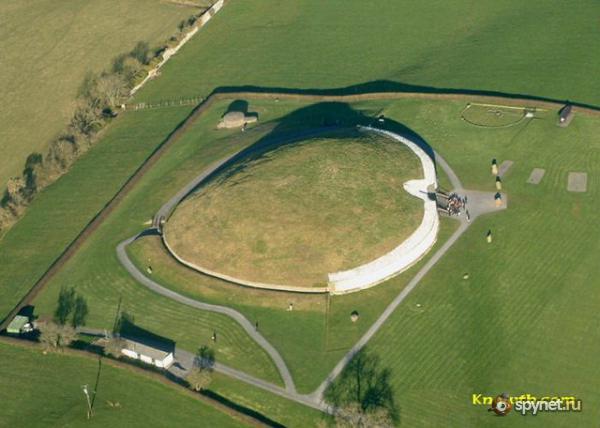

A huge complex of Newgrange (Newgrange) was built between 3100 and 2900 BC, which means that it approximately 5000 let.V Newgrange Neolithic period, served as a center for rituals and ceremonies. Later, it was added to the many other monuments.

Over time, the complex began to decrease due to the subsidence of the embankment, and soon disappeared completely. This area has long been used as farmland. In 1688 these lands passed into the possession of Charles Campbell. It was his servant found Newgrange, when looking for the stones for construction. At first it seemed to them a simple construction of the cave, but then was found a long, narrow passage leading to the great room.

The workers immediately reported the discovery to the owner, who told this antiquarian, naturalist and philologist Edward Luidja. As a result, Luidja Newgrange announced his discovery and called it a tomb, to put it simply prehistoric tomb. Later, many questioned this hypothesis, for example, Charles Vallance, who thought that this place probably used for rituals and astronomical purposes. In 1983, Martin Brennan published the book "Stones of Time," which results in a lot of detail to refute the theory of the burial tomb.

Large-scale studies began in 1962 under the direction of Professor Michael J.. O'Kelly. Newgrange was excavated and restored, was built around a wall of quartzite and granite to strengthen the embankments. This recovery has displeased the archaeological community, critics argue that such technology did not exist when this building was erected. Another reason for the discontent was the fact that the stones were brought from other regions of the country.

The height of the mound - 13 5 m, diameter - 85 meters. 18-meter-long corridor leads to the burial chamber, consisting of vertically set stone monoliths weighing 20 to 40 tons. Location burial chamber reminiscent of Stonehenge, only here on top of the roof is covered with stone embankment of earth and rubble. It is necessary to pay tribute to the mysterious builders of this building, for 5000 years, the roof leaked, and almost does not pass moisture until now.

Inside the chamber, a large preserved ritual bowl and carved niches in the walls, decorated with stone carvings. Above the bathroom is a stepped vault. Monoliths, its generators are arranged so that the bottom of the stones are darkest and their weight is reduced at the vertex. The dome forms a hexagonal shaft tapered upwards to a height of 6 meters.

The tunnel is directed to the southeast, to the side of the sunrise at the winter solstice. Above the entrance is a hole - a window of 20 cm in width, through which sunlight can penetrate to the inside of the room. Within a few days (mid-December), the rays of the rising sun penetrate through the tunnel into the chamber and brightly illuminate it for about 20 minutes.


Few wishing allowed to watch the beautiful spectacle of the penetration of sunlight into the inner chamber at dawn. For example, in 2005 there were only 50 people selected from 27,000 applicants. To determine the lucky conducts special lottery allowed only 10 visitors a day. The moment of penetration of the sun's rays can be seen in the photo below:




In 1993, UNESCO officially awarded the archaeological complex of Brú na Bóinne international status of the historical monument. In the list of World Heritage Newgrange described as the largest and most important of megalithic structures in Europe. More than 200 000 people visit this unique archaeological monument annually.












